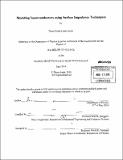| dc.contributor.advisor | Karl K. Berggren. | en_US |
| dc.contributor.author | Aude, Diana Prado Lopes | en_US |
| dc.contributor.other | Massachusetts Institute of Technology. Dept. of Physics. | en_US |
| dc.date.accessioned | 2011-02-23T14:37:11Z | |
| dc.date.available | 2011-02-23T14:37:11Z | |
| dc.date.copyright | 2010 | en_US |
| dc.date.issued | 2010 | en_US |
| dc.identifier.uri | http://hdl.handle.net/1721.1/61254 | |
| dc.description | Thesis (S.B.)--Massachusetts Institute of Technology, Dept. of Physics, 2010. | en_US |
| dc.description | Cataloged from PDF version of thesis. | en_US |
| dc.description | Includes bibliographical references (p. 53-54). | en_US |
| dc.description.abstract | This thesis develops a simulation tool that can be used in conjunction with commercially available electromagnetic simulators to model the behavior of superconductors over a wide range of frequencies. This simulation method can be applied to metals both in the normal and superconducting state and is based on calculating surface impedance as a function of temperature, frequency and material parameters (such as the coherence length and the normal state conductivity). The surface impedance calculations apply the Mattis Bardeen and Zimmermann formulations of conductivity for superconductors to classical transmission line theory. When the tool is used with the Zimmermann formulation, it can model the behavior of superconductors with arbitrary purity, including very clean superconductors, which cannot be handled correctly by the Mattis Bardeen conductivity approach used in current simulators such as SuperMix [1]. Simulations were performed using the developed tool with Ansoft's HFSS EM simulator. The results for a copper printed circuit board resonator showed very good agreement with measured data, attesting to the soundness of the transmission line theory used to develop this tool. A microfabricated niobium coplanar waveguide resonator - for use in quantum computing applications - was also modeled and simulations gave the expected results for the electric field distributions and the variation of Q with temperature and capacitive coupling. The tool developed here can therefore be used to predict the electromagnetic behavior of a superconducting device as function of the material parameters, operating temperature and frequency. With measurements of the device's Q at a recorded frequency and temperature, this tool can also be used to determine the mean free path of the material (assuming other material parameters such as coherence length, transition temperature (Tc) and the ratio of the energy gap to kBTc are known). Equivalently, if all material parameters are known, comparison of Q measurements with simulation results can be used to determine the operating temperature, which may otherwise be difficult to measure in cryogenic environments. | en_US |
| dc.description.statementofresponsibility | by Diana Prado Lopes Aude. | en_US |
| dc.format.extent | 62 p. | en_US |
| dc.language.iso | eng | en_US |
| dc.publisher | Massachusetts Institute of Technology | en_US |
| dc.rights | M.I.T. theses are protected by
copyright. They may be viewed from this source for any purpose, but
reproduction or distribution in any format is prohibited without written
permission. See provided URL for inquiries about permission. | en_US |
| dc.rights.uri | http://dspace.mit.edu/handle/1721.1/7582 | en_US |
| dc.subject | Physics. | en_US |
| dc.title | Modeling superconductors using surface impedance techniques | en_US |
| dc.type | Thesis | en_US |
| dc.description.degree | S.B. | en_US |
| dc.contributor.department | Massachusetts Institute of Technology. Department of Physics | |
| dc.identifier.oclc | 701906470 | en_US |
